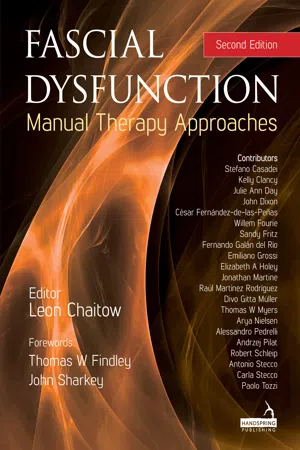SECTION II | Selected Fascial Modalities |
CHAPTER 6 Bowen therapy
Kelly Clancy
CHAPTER 7 Connective tissue manipulation and skin rolling
Elizabeth A. Holey, John Dixon
CHAPTER 8 Use it or lose it: recommendations for fascia-oriented training applications in sports and movement therapy
Robert Schleip, Divo Gitta Müller
CHAPTER 9 The Fascial Manipulation® method applied to low back pain
Antonio Stecco, Stefano Casadei, Alessandro Pedrelli, Julie Ann Day, Carla Stecco
CHAPTER 10 Functional fascial treatment: fascial unwinding and balanced ligamentous tension technique
Paolo Tozzi
CHAPTER 11 Gua sha (press-stroking) and Ba guan (cupping): traditional East Asian instrument-assisted manual therapies
Arya Nielsen
CHAPTER 12 Muscle energy techniques
Leon Chaitow
CHAPTER 13 Myofascial Induction Therapy (MIT®)
Andrzej Pilat
CHAPTER 14 Neuromuscular technique (NMT) and associated soft tissue manipulation (neuromuscular) modalities
Leon Chaitow
CHAPTER 15 Positional release techniques (including counterstrain)
Leon Chaitow
CHAPTER 16 Rolfing® structural integration
Jonathan Martine
CHAPTER 17 Global Postural Re-education®: Souchard method
Emiliano Grossi
CHAPTER 18 Management of scars and adhesions
Willem Fourie
CHAPTER 19 Manual matrix remodeling in myofascial injuries: scar modeling technique
Raúl Martínez Rodríguez, Fernando Galán del Río
CHAPTER 20 Massage therapy and fascia
Sandy Fritz
CHAPTER 21 Trigger point release methods including dry needling
César Fernández-de-las-Peñas
INDEX
Chapter 6
Bowen therapy
Kelly Clancy
What is Bowen therapy?
Bowen therapy is a neuromuscular technique comprised of a series of gentle ‘rolling moves’ applied to the soft tissues at specific anatomical locations. Following any move, or series of moves, Bowen requires a significant pause in treatment, suggested to allow adaptive integration of the stimulus via the nervous and fascial systems. Some interpretations of Bowen therapy utilize procedures, which are standardized sequences of therapeutic ‘moves’ performed in a precise location, direction, depth, and order, to elicit a therapeutic response. Other interpretations allow for customized application of moves based upon individualized assessment findings.
Bowen theory embraces a minimalist ‘less is best’ approach. Unlike many other manual approaches, which aim to directly alter tissue tension or postural alignment by means of massage strokes, manipulation, or stretching techniques, the Bowen practitioner aims to induce and facilitate a shift from tension patterns and neurologic dysregulation towards a state of relaxation and balance using the body’s own innate tendency toward homeostasis (see also Ch. 13 Myofascial induction therapy (MIT®)).
History of Tom Bowen
Tom Bowen (1916–1982), though never formally trained as a healthcare provider, was said to have been influenced by osteopathic and Japanese acupressure concepts via a local ‘physical manipulator’ named Ernie Saunders in the late 1940s. Bowen also had a strong interest in sports and in helping injured co-workers by using his hands-on technique at the factory where he was employed in Geelong, Australia. Bowen refined his methods with these groups and eventually opened a clinic as a ‘Natural Therapist’, practicing from 1959 until his death in 1982.
As his popularity in the Geelong community and outlying areas began to grow, other practitioners began inquiring about his techniques and methods. Bowen allowed six practitioners, whom he affectionately called his ‘boys’, to observe his work over a span of eight years. Keith Davis, Kevin Neave, Nigel Love, Oswald (Ossie) Rentsch, Romney Smeeton and Kevin Ryan came from a variety of backgrounds, including chiropractic, osteopathy, naturopathy and massage therapy. They spent considerable time in his clinic observing, each interpreting and transforming the methods applied. Bowen himself never published details of his technique, nor specified in written form the indications for particular treatment interventions.
Two of these practitioners, Kevin Ryan (an osteopath) and Kevin Neave (a chiropractor), taught their interpretation of Bowen’s work to osteopathic students and other practitioners in Australia. Another, massage therapist Oswald (Ossie) Rentsch, became the co-founder of Bowtech Pty Ltd and the Bowen Therapy Academy of Australia. Rentsch expanded the method internationally, reaching large audiences by developing a standardized format for the work. Rentsch described easy-to-follow procedures and indications for use which were put into manuals in modular formats, allowing for multiple instructors and worldwide reach.
Currently, a variety of Bowen schools and methods, all sharing the commonality of the use of the ‘move’, are practiced and taught. Differences are largely minor, relating to location, direction, pressure, sequencing, pauses and assessment methods (see notes on therapeutic dosage in Ch. 5). These organizations include Bowtech, College of Bowen Studies, The Bowen College, Smart Bowen, International School of Bowen Therapy, Fascial Kinetics, Fascia Bowen, Neurostructural Therapy and others. Many, though not all, are direct offshoots from Rentsch’s original interpretation published as ‘The Bowen Technique – an interpretation by Oswald Rentsch’ (Rentsch 2013). While there has been an attempt to bring these schools together in order to grow awareness of the power and effectiveness of Bowen therapy, the discipline remains fractured. Disagreements persist regarding how Tom Bowen practiced, how Rentsch came to know and claim the work, how Bowen therapy should be performed, ways of assessment, and the future direction of this dynamic modality. What does remain a commonality with all of the training programs and Bowen practices is the belief that with specific input utilizing cross-fiber moves, the body will integrate the input as a way to restore itself toward homeostasis.
Philosophy
The main premise behind Bowen therapy is that the body maintains an innate capacity to heal itself. The primary role the practitioner plays during a session is in facilitating, with minimal input, the body’s natural ability to repair and regulate itself (Rentsch 2013). Symptoms in the form of pain, pathology, systemic dysregulation, or postural asymmetries are all seen to represent expressions of failed or failing adaptation. Homeostasis is defined as the dynamic process by which an organism maintains and controls its internal environment despite perturbations from external forces (Clayman 1989). In line with osteopathic precepts, Bowen therapy aims to work with the underlying principle of ‘structure governing function’, suggesting that disturbances of structure, at any level, result in body-wide adaptive modific...
